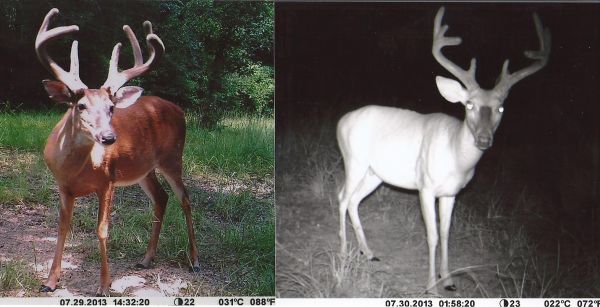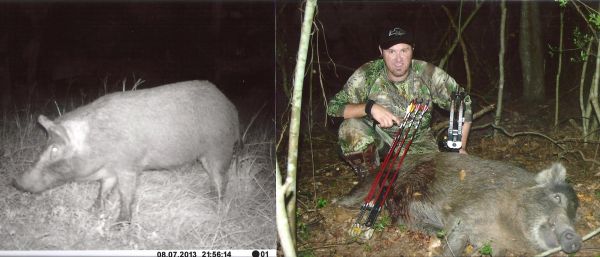
Deer season is finally open
What goes around comes around, and once again the deer season has arrived in the Bayou State.
Hopefully you have been taking my advice and are fully prepared for the new season; if not, lots of luck and hope it works out for you.
The rainfall Mother Nature has provided us this year in the Felicianas has kept the jointvetch and cowpeas growing strong. Along with sawtooth acorns and white oaks that will hopefully start dropping their sweet nuggets in a few weeks, these plots will provide hunting opportunities with the crossbow this month.
Heck, I even have green clover and chickory in the strips I planted last fall; now I have to figure out if I just bush-hog and fertilize, and let them start over again or do something else. I am not sure I want to plow up good rootstock and sow new seed.
The final totals are in from the 2012 deer season, and the statistics point to a low deer harvest — one that ties the 1980 harvest 32 years ago. However — and that is a big however — that harvest figure is based on a harvest survey method that allows LDWF to compare the apples of 1980 with the apples of 2012.
In 1980, all deer hunters were purchasing basic hunting licenses, which are what the survey method design (this design was developed in the ’60s) uses to select hunters.
Guess what? That survey method only chooses hunters who purchase the basic hunting license; us senior license buyers (33 percent of today’s hunters) are not included in the survey, nor are the bulk of the lifetime license holders (the survey does sample 1,000 of them, but that is a small fraction of the hunters who have lifetime licenses).
When the harvest equation considers the harvest of the senior license holders, the 2012 deer harvest jumps up to 152,800 deer — a much more realistic number, and one that is probably in line with what is really going on.
But because the LDWF has used this old equation forever, and it allows a statistically valid comparison between all years, the low harvest figure is used.
I think it is time to develop a new harvest method: one that will equally sample all user groups, one that is in line with what is happening in the license world today.
LDWF does have a way to monitor the harvest and sample all hunters equally: Simply use the deer tag data base, since all hunters have to have deer tags.
But again, this changes the equation that has been in use for years; so what if it is out of step with today’s hunters.
Anyway, the book is closed on the 2012 deer season, and it is time to start collecting harvest data for 2013.
And this means it is imperative that you report your deer harvest. LDWF has made some changes in the reporting program, and now there is supposed to be a live operator to take your calls when you report your deer.
The 2012 pig harvest is raising some eyebrows at LDWF: The harvest survey showed that 161,600 hogs were harvested last year. That’s more pigs than deer.
Some are worried by this but, really, this should not be a surprise. The hog population has dramatically increased around the state; the pig season is year-round with gun, and some of it is at night, and there is no limit on pigs.

Last year, I killed 11 hogs and five deer.
I am sure that landowners with much more land than I have are killing a lot of pigs. When one adds in the harvest from trapping operations, it should not be a surprise that more hogs are taken than deer. There is concern due to hogs testing positive for several diseases, swine brucellosis being one. While this is not good, we should not go into a panic mode. Hunters need to use common sense, and take precautions when harvesting and cleaning wild hogs. Use rubber gloves, clean up after butchering, clean knives and other tools, and don’t eat or drink when cleaning hogs.
In the book Field Manual of Wildlife Diseases in the Southeastern U.S., Dr. Randy Davidson wrote that, while humans have contracted swine brucellosis from handling and dressing wild swine, the cases are extremely rare considering the thousands of animals harvested every year.
With the start of the 2013 deer season, the nighttime pig season comes to a close, unless you get the permit from LDWF. Hogs can still be harvested during legal hunting hours, and hunters should harvest all pigs when they see them.
That said, my best hog success comes during the spring and summer months, after the deer season. With the opening of the deer season, hunters are putting out a ton of bait, and it is hard to get pigs on the bait when so much is available. Hogs, just like deer, readily eat acorns, and once the acorns start hitting the ground the pigs shy away from bait just like the deer.
In August, I had the opportunity to meet the Pigman, Brian Quaca. He is quite the character and loves to pursue the wild hogs. He came and hunted with Bowie Outfitters’ David Reynerson on private land around Clinton, and I told David I would see if I could get some pigs on bait, also.
Pigman and his cameraman were filming a segment for his show and went out one of the nights with Dr. Jim LaCour, the LDWF wildlife vet. The next night, I put them in a ground blind at a site that had a big boar coming around 9:30 p.m.
Pigman was going to use his bow and shoot one under the solar lights. This was the first time the pig saw the lights and it was a little nervous, but it finally moved in on the rice bran, and Pigman drilled it.
The pig was very fat, and even though the mechanical broadhead put a big hole through the pig, the lard closed the hole and the blood trail wasn’t much. But the arrow had cut through the liver, which is always a killing shot, so the hog only went 30 yards or so. Check out this episode of the show: The video of the arrow flying through the air and into the pig is a sight to see.
There were some nice bucks killed last season, and I anticipate another good harvest of trophy deer. The rainfall this year has been more frequent, and the deer growth and development my cameras have captured has been excellent, even though our habitat is predominantly pine.
As we all know, the key to growing big deer is having excellent habitat with plenty of year-round groceries. As I always say, the deer season will end but the deer management work goes on throughout the year. If you have been doing the work, your season should be good.
LDWF provides plenty of opportunities for our youth hunters, so let me encourage you to take some young people to the woods this season.
Chloe Slayter of Pineville and Brandon Fryar of Olla were the 2012 Youth Hunters of the Year. This program is for youth hunters 15 years old or younger. Check out the LDWF or Louisiana Outdoor Writers Web sites for more information about the program.
Chloe killed a 14-point buck on the Richard Yancey (formerly Red River) WMA, and Brandon went on a duck hunt on the Boeuf WMA that turned out to be an adventure when he and his uncle had to rescue some other hunters. Read more about these young hunters on the LOWA website and read more about these two young hunters. With youths like Chloe and Brandon, the future of hunting in Louisiana looks good and our tradition should remain strong.


